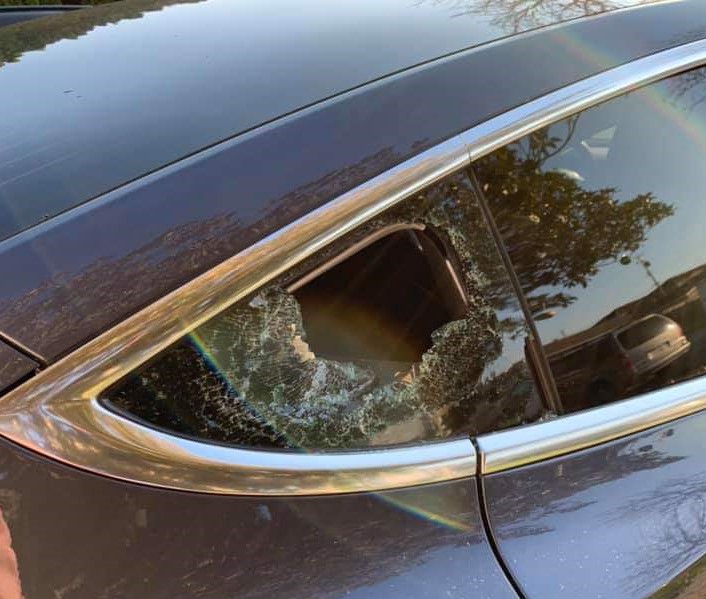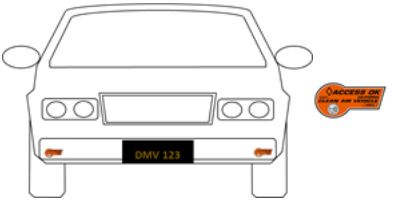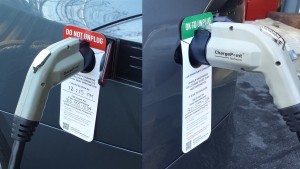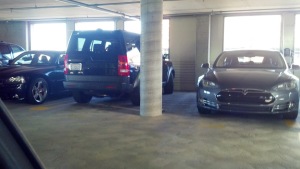
An unfortunate reality of owning a Tesla in the bay area is the rash of break ins that have been occuring. In summary, these are the seven recommended steps to avoid having your vehicle broken into:
- Keep the rear seats folded down when not in use
- Leave no valuables or electronics in the vehicle
- Use a white or light colored towel on the trunk floor making it very easy to see that there are no valuables in plain sight
- Have notifications turned on for your Tesla App
- Have Sentry mode armed whenever leaving the vehicle on the street, in a parking lot or driveway.
- Make sure your dashcam is configured, enabled and maintained
- If you must leave electronics in the vehicle, be sure they are stored in the frunk or under the false floor in the rear trunk and completely powered down. Also be sure to place the items in these locations BEFORE you get to your destination.
Why is this happening?
In short, it’s a combination of causes. California has reduced the penalties for property crimes so the risk to reward for criminals is very low. The bay area has become a cluster area for these crimes. The San Francisco Chronicle reported that the San Francisco area led the state in property crime with nearly twice the rate of the Los Angeles area, yet ranked 50th of 58 counties for arrests.
A mere fraction of Tesla break ins from the map site bit.ly/3breakins
Tesla’s do not come with standard equipment for a passive glass break sensor in it’s alarm system and the rear seats can be folded down from the passenger cabin. Tesla’s passive alarm is only triggered when a door or trunk/front trunk is opened while the car is locked. Tesla owners are also known to be affluent, chances are they have left some sort of valuable in the vehicle. In short, Teslas are an easy target to break into, and to find valuables quickly and silently.
How is it done?
Criminals typically look for vehicles in public spaces, mainly parking lots but also search for vehicles left on the street and in driveways. They pull up in a getaway vehicle posing as a car looking for a parking space, the perpetrator usually gets out of the getaway vehicle crouched down from the rear, then look in the vehicle for valuables. If the rear seats are in their standard position, they smash the small triangular rear corner window on the vehicle with their elbow, gloved fist or a hard object, reach in, release the rear seat to fold the rear seat down and continue to look for valuables in the trunk area. If they see something of value in the trunk, they then smash the larger passenger window, reach in or climb in to avoid sounding the entry alarm and snatch the valuables. All of this can happen in less time than a NASCAR pitstop with no more noise than dropping a pile of pebbles on the asphalt when the safety glass shatters. A good compilation of break ins from Tesla Sentry Mode videos can be found here as posted on YouTube by “Teslacam Justice”.
How can break ins be prevented?
While preventing break ins will never be completely foolproof, there are seven measures owners can take to help prevent break ins. We have listed the most effective methods in a bulleted summary above along with detail for each of those methods below in order of effectiveness.
1. Keep the rear seats folded down when not in use
Typically the first action a criminal takes after identifying the vehicle is to look inside for valuables. To make your vehicle as little of a target as possible, make it very easy to look inside the vehicle. This means keeping your rear seats folded down when not in use. This simple step is probably the most practical solution in preventing theft provided you can keep the trunk area free of valuables and do not have child seats in the car. If you have a single child’s car seat, position in the center or behind the driver so that the smaller rear seat on the passenger side can be kept folded down.
2. Leave no valuables or electronics in the vehicle
Do not leave packages, backpacks, or other items in your vehicle. It’s also critical to not leave your phone in the vehicle as it can literally be used as a car key if the Tesla app is installed. Take your valuables with you whenever you leave the vehicle in public and plan your errands appropriately so that if you need to leave items in the vehicle, they are of the least value and for an absolute minimum amount of time. When outside the vehicle, be aware of how far your phone key is kept away from the vehicle. Try to store your phone at least 40 feet away from the vehicle to avoid accidentally leaving the vehicle unlocked. If you do store your phone, within 40 feet, be sure to use your phone to lock the vehicle.
3. Leave a white or light colored towel on the trunk floor making it very easy to see that there are no valuables in plain sight
Seats down with a light colored towel make it readily apparent that the back of the vehicle is empty
Since the trunk carpet is a dark upholstery, someone looking quickly into the back of the vehicle may mistake an article of clothing or other low value item as something of importance. By using a light contrasting item on the floor, such as a towel or sheet, it becomes very easy to see that there is nothing of value in the rear of the vehicle.
4. Notifications turned on for your Tesla App
Be sure your Tesla app on your phone is set to alert you if your alarm is sounded. This can be found under the gear icon in the upper-left corner of the app and clicking on Notifications. In the notifications under the security section, be sure the checkmark next to Car Alarm is checked. If something should activate the car alarm, an alert will then be sent to your phone. Always use caution when responding to an alarm.
5. Activate Sentry mode whenever leaving the vehicle on the street, in a parking lot or driveway
Make it a habit of turning on Sentry Mode whenever you park in public. Note that Sentry Mode will use about 1 mile equivalent of energy per hour while it is activated and will not operate if the car is at a state of charge below 20%. With Sentry Mode activated, the car will flash the lights if someone approaches and display a warning on the center display letting people know they are being recorded. Most importantly, the alarm will activate if a window is broken and will play music at full volume to create a situation to draw attention to the vehicle. There are several methods to activate Sentry Mode.
From the app: Go to the Controls section and click the switch next to Sentry Mode to activate. The switch icon will turn blue when activated.
From the vehicle: Click the Sentry icon in the top right corner of the center screen. The icon turns red in the center when activated or black when deactivated.
There are also other Sentry mode settings available from the vehicle. Please refer to the manual for detailed information.
With Sentry mode you do not necessarily need to have USB storage for recording, but it is very helpful in case an incident has occurred. The alarm will still activate if there is activity and warnings will be presented on the main screen, but the system will not save any data to the vehicle without the dashcam being configured.
6. Make sure your dashcam is configured, enabled and maintained
Having your dashcam configured is very important. It may provide key evidence and help police track down suspects should your car ever get broken into. Essentially you want at least a 128 gigabyte hi-speed dashcam rated storage. Essentially you want Class 10 U3 SD card and a USB-A adapter. This type of card is suited to the frequent writing, vibration and temperature variations in a vehicle. The storage card should be formatted to FAT-32 and a folder called TeslaCam should be added to the root directory. You can Google instructions on how to configure the storage or companies such as puretesla.com have plug and play solutions that are already formatted and ready to use.
Once properly configured, you can see the dashcam icon on your center display
With the dashcam enabled, you then need to make sure you can easily retrieve data from the dashcam storage, preferably from your mobile device as you may need to show the video to law enforcement at the scene. Be sure you have an adapter that works with your phone and practice regularly how to retrieve data. Typically these are Micro-USB or USB-C Andriod phones and Lightning adapters for iPhones. I recommend reviewing Step 5 from this LivingTesla.com post on how to retrieve videos.
7. If you must leave electronics in your vehicle, hide them in the frunk or under the trunk false floor
If you must leave electronics in the vehicle, be sure they are stored in the frunk or under the false floor in the rear trunk and completely powered down. Thieves are not only using a flashlight to look for valuables, some have become more sophisticated and are pinging for Bluetooth and WiFi signals to figure out if a phone or laptop is left in a parked car. Be sure to put your device in Airplane mode and power it down completely to reduce the risk of being pinged. Also be sure to place the items in the frunk or under the false floor BEFORE you get to your destination. Thieves case parking lots and will watch for valuables being placed in hidden locations. These locations are not foolproof, but the probability is lower that thieves would want to take the time to get to these locations and opening the frunk will set off the alarm.
Lastly, look at your insurance situation. If you frequent areas with high break ins, you may want to lower your comprehensive deductible or inquire your insurance agent to see if glass break insurance is offered with a lowered deductible.
The cost to replace the small triangular window is anywhere from $300 to $500+, the larger passenger window runs about $400. Without a lower deductible or glass break insurance, you may want to pay the cost out of pocket. Tesla service centers can replace the glass at the lowest price, but there will probably be a backlog of several weeks to get an appointment. Private authorized firms can probably respond faster with a mobile repair appointment, but the cost will be higher.
Devices marketed to prevent break ins
Nearly all devices on the market are not truly effective in preventing window breakage. They may prevent valuables from getting stolen, but owners will still experience some sort of damage to their vehicle from a break in attempt. Remember that the primary goal of a thief is to get into your car and to grab something of value as quickly as possible, they are not going to read a sticker or know the latest device. They are more familiar with the 90% situation and will be working under the assumption that there is no device is in place.
I am listing some of the more common accessories people buy and what the benefits and drawbacks are for each. I do not recommend any of these products, but wanted to give information on each so you can make an informed decision in case you are considering security accessories.
Trunk Shield
Website: https://www.ebay.com/itm/Tesla-Model-3-Trunk-Shield-White-/143109245393
Cost: $150
TrunkShield is a sheet of powder coated aluminum that is to be used as a physical barrier between the trunk and passenger compartment. Simply bolt in with wing nuts attaching from the trunk space. Trunk Shield comes in either black or white.
Advantages: Creates a true barrier between the passenger compartment and trunk space.
Drawbacks: Still requires the seats to be folded down to show the barrier, finger holes could still be used to see through the barrier to find valuables. Also need to be removed to use the full cargo space if transporting large items.
Drop Lock
Website: https://getdroplock.com/
Cost: $24.99
DropLock is a plastic device that is placed in the seat lowering latch to prevent folding down or the seat to gain entry into the trunk. Includes “SEATS LOCKED” stickers
Advantage: Easy to install low-cost device the prevents lowering the rear seats from the passenger compartment.
Drawbacks: Low surface quality 3D-printed plastic device that could probably be destroyed with a quality screwdriver. Relies on the thief reading the window sticker and believing the seats are locked. There are quite a few images of broken windows with the “SEATS LOCKED” sticker.
Rear window security film
Cost: $48.75 (Installation Free to self install to $200+ professionally installed)
By installing a .0045 inch film, it should make it much more difficult to shatter the rear corner window to lower the back seat. RPMTesla does a nice job of providing a video of attempting to break the window with multiple devices where the clearfilm appears to hold up.
Advantage: Probably the least intrusive security accessory. Once installed, the product is practically invisible. Product is also made of Clearplex which is designed to be used in exterior applications (Other providers are providing a film that is not designed for exterior applications and will probably suffer from ultraviolet exposure over time)
Drawbacks: At a cost of about $50 a square foot for material (Plus installation), this is one of the most costly options available and only protects the smaller rear corner window. The thief’s goal is to get into the vehicle and if the smaller window won’t break, they will simply break the larger window to get into the car. If you then coat the larger window, and you start risking safety in a side impact crash. The glass can still be damaged with Clearplex if hit hard enough, so it is still not a good solution.
Glass break sensors
Cost: $12.99
Glass sensor pucks can be stuck to the corner windows to activate a 120db siren if the window is struck or broken.
Advantage: Low cost, easy to install, readily apparent there is a security device on the window.
Drawback: Can probably set off a false alarm on a rough road while driving. Would be difficult for anyone to hear when the alarm is going off inside the vehicle. Doesn’t really look very good. May not activate if the larger window is broken.
Lighting
Cost: $73.75
By providing additional lighting inside the vehicle, a lighting strip along with keeping the seats down can make it readily apparent that nothing of value is within the trunk. Use of the lighting strip as a security device requires you to leave the interior lights on while parked. There are also other solutions for leaving lights on such as a solar charged camping lanterns that will not draw power from the vehicle.
Advantages: Easy to install. Simply replace the existing bulb and use the provided adhesive tape to fasten the LED light strip to the top of trunk. Provides better visibility for finding items in your trunk at night.
Drawbacks: Can drain the 12 volt battery. Essentially does the same job as placing a $7 towel in the backseat. Can draw attention to the vehicle by having a light on.
Reporting break ins and being vigilant
It is important to report any break in to your vehicle, regardless of the enthusiasm of law enforcement to take a report. Reporting the crime helps provide crime statistics and may cover you in the event that your personal information and identity gets compromised. By being vigilant and taking the seven steps above, you will greatly reduce your risk of being the victim of a break in. If you capture video of a break in and can share it with law enforcement, you greatly increase your chance of law enforcement investigating your case. Share this post with other Tesla owners and let us know if you have any other suggestions that we can include in an update to this post.





